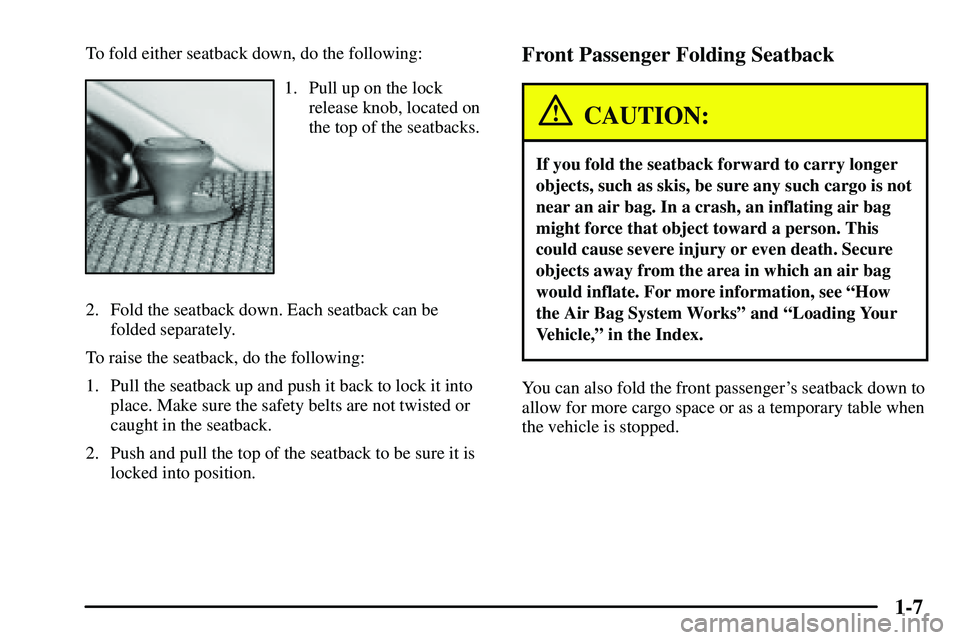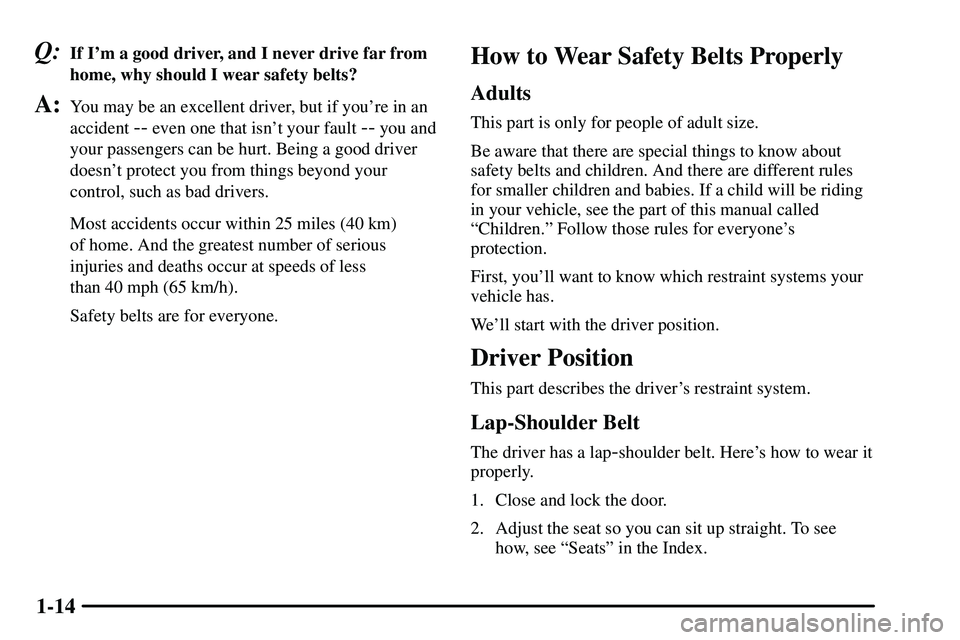Page 8 of 381
1-2
Seats and Seat Controls
This part tells you about the seats -- how to adjust them,
and also about reclining front seatbacks, head restraints
and rear folding seatbacks.
Manual Front Seats
CAUTION:
You can lose control of the vehicle if you try to
adjust a manual driver's seat while the vehicle is
moving. The sudden movement could startle and
confuse you, or make you push a pedal when you
don't want to. Adjust the driver's seat only when
the vehicle is not moving.
Lift the bar located under the front seat to unlock it.
Slide the seat to where you want it and release the bar.
Try to move the seat with your body, to make sure the
seat is locked into place.
Don't put anything under the front seats. Items under
the seats could keep the seats from locking into place
properly.
Page 9 of 381
1-3 Driver's Seat Height Adjuster
Turn the knob located on
the outboard side of the
driver's seat cushion to
adjust the height of the
driver's seat. It is easier to
use the adjuster when the
seat is unoccupied. Make
sure the ignition is off and
the vehicle is in PARK (P)
before adjusting the seat.
Reclining Front Seatbacks
To adjust the seatback, lift the lever located on the
outboard side of the seat. Release the lever to lock the
seatback where you want it. Push on the seat to make
sure it's locked into position. Pull up on the lever
without pushing on the seatback, and the seat will go to
its original upright position.
Page 12 of 381
1-6 Rear Seats
Rear Folding Seatback
You can fold either side of the seatback down for more
cargo space. The rear right side seatback can also be
used as a temporary table when the vehicle is stopped.
Make sure the front seatback isn't reclined or in the
rearward most position. If it is, the rear seatback won't
fold down all the way.
CAUTION:
If the seatback isn't locked, it could move
forward in a sudden stop or crash. That could
cause injury to the person sitting there. Always
press rearward on the seatback to be sure it
is locked.
CAUTION:
A safety belt that is improperly routed, not
properly attached, or twisted won't provide the
protection needed in a crash. The person wearing
the belt could be seriously injured. After raising
the rear seatback, always check to be sure that
the safety belts are properly routed and attached,
and are not twisted.
Page 13 of 381

1-7
To fold either seatback down, do the following:
1. Pull up on the lock
release knob, located on
the top of the seatbacks.
2. Fold the seatback down. Each seatback can be
folded separately.
To raise the seatback, do the following:
1. Pull the seatback up and push it back to lock it into
place. Make sure the safety belts are not twisted or
caught in the seatback.
2. Push and pull the top of the seatback to be sure it is
locked into position.
Front Passenger Folding Seatback
CAUTION:
If you fold the seatback forward to carry longer
objects, such as skis, be sure any such cargo is not
near an air bag. In a crash, an inflating air bag
might force that object toward a person. This
could cause severe injury or even death. Secure
objects away from the area in which an air bag
would inflate. For more information, see ªHow
the Air Bag System Worksº and ªLoading Your
Vehicle,º in the Index.
You can also fold the front passenger's seatback down to
allow for more cargo space or as a temporary table when
the vehicle is stopped.
Page 14 of 381
1-8
To fold the seatback down, do the following:
1. Lower the head restraint to the lowest position and
make sure the seatback is at the most upright
position and locked.
2. Pull up on one of the
recliner levers located
on either side of the
back of the passenger's
seatback.
3. Fold the seatback down.
4. Lift the recliner lever to make sure the seatback is
completely flat.
To raise the seatback, do the following:
1. Pull the seatback up and push it back to lock it into
place. Make sure the safety belt is not twisted or
caught in the seatback.
2. Push and pull the top of the seatback to be sure it is
locked into position.
3. Use the recliner lever to adjust the seatback to a
comfortable position.
Page 20 of 381

1-14
Q:If I'm a good driver, and I never drive far from
home, why should I wear safety belts?
A:You may be an excellent driver, but if you're in an
accident
-- even one that isn't your fault -- you and
your passengers can be hurt. Being a good driver
doesn't protect you from things beyond your
control, such as bad drivers.
Most accidents occur within 25 miles (40 km)
of home. And the greatest number of serious
injuries and deaths occur at speeds of less
than 40 mph (65 km/h).
Safety belts are for everyone.
How to Wear Safety Belts Properly
Adults
This part is only for people of adult size.
Be aware that there are special things to know about
safety belts and children. And there are different rules
for smaller children and babies. If a child will be riding
in your vehicle, see the part of this manual called
ªChildren.º Follow those rules for everyone's
protection.
First, you'll want to know which restraint systems your
vehicle has.
We'll start with the driver position.
Driver Position
This part describes the driver's restraint system.
Lap-Shoulder Belt
The driver has a lap-shoulder belt. Here's how to wear it
properly.
1. Close and lock the door.
2. Adjust the seat so you can sit up straight. To see
how, see ªSeatsº in the Index.
Page 21 of 381
1-15
3. Pick up the latch plate and pull the belt across you.
Don't let it get twisted.
The shoulder belt may lock if you pull the belt across
you very quickly. If this happens, let the belt go back
slightly to unlock it. Then pull the belt across you
more slowly.4. Push the latch plate into the buckle until it clicks.
Pull up on the latch plate to make sure it is secure.
If the belt isn't long enough, see ªSafety Belt
Extenderº at the end of this section.
Make sure the release button on the buckle is
positioned so you would be able to unbuckle the
safety belt quickly if you ever had to.
5. To make the lap part tight, pull down on the buckle
end of the belt as you pull up on the shoulder belt.
Page 22 of 381

1-16
The lap part of the belt should be worn low and snug on
the hips, just touching the thighs. In a crash, this applies
force to the strong pelvic bones. And you'd be less likely
to slide under the lap belt. If you slid under it, the belt
would apply force at your abdomen. This could cause
serious or even fatal injuries. The shoulder belt should go
over the shoulder and across the chest. These parts of the
body are best able to take belt restraining forces.
The safety belt locks if there's a sudden stop or crash, or
if you pull the belt very quickly out of the retractor.Shoulder Belt Height Adjuster
Before you begin to drive, move the shoulder belt
adjuster to the height that is right for you. Adjust the
height so that the shoulder portion of the belt is centered
on your shoulder. The belt should be away from your
face and neck, but not falling off your shoulder.
To move it down, squeeze
the button and move the
height adjuster to the
desired position. You can
move the adjuster up just by
pushing up on the shoulder
belt guide. After you move
the adjuster to where you
want it, try to move it down
without squeezing the
release button to make sure
it has locked into position.